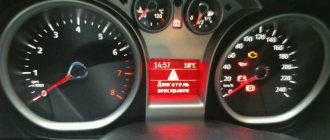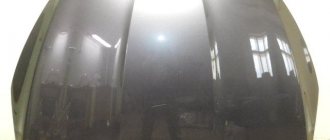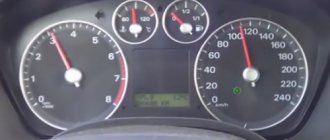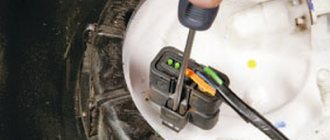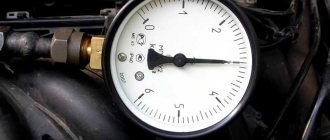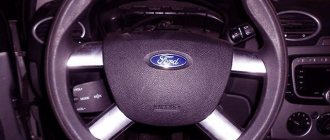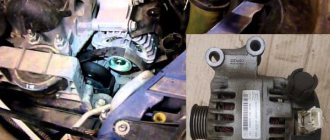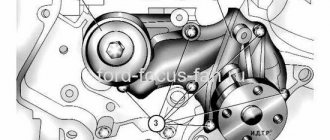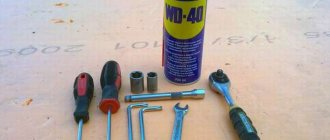Typical problems
The fuel pump (2nd generation Ford Focus) can fail for various reasons. A characteristic sign of a malfunction is a hum when the pump operates. Even new products can hum. If the humming is particularly loud, then this indicates that the mechanism has burned out. If the Ford Focus 2 fuel pump does not start, this indicates that it is not pumping fuel. The engine, accordingly, cannot operate even at idle. Often, elements on these cars fail due to their service life - on average, one original device can work for 5-7 years.
Signs of trouble
If, when accelerating, the engine does not run smoothly, but jerks occur, this directly or indirectly indicates a problem with the fuel pump. This happens when the pipes in the fuel system are clogged. Normal circulation of fuel through the system is simply impossible. Another sign that indicates a malfunction is a strong noise, which is especially audible at idle in the rear of the car.
How to check the fuel pump?
Before pronouncing a death sentence on a device, experts recommend testing it. Testing or diagnostics will include checking the electrical supply as well as the pressure. The first thing you need to pay attention to is the fuel pump fuse. "Ford Focus 2" is equipped with this in any configuration. It is located in close proximity to the control unit.
Is it possible to repair Ford Focus 2 fuel pumps?
A dead pump is not always completely broken. Sometimes only one of the components is faulty. To determine what has gone wrong, you will need diagnostics. From time to time, the parts of the unit need to be washed and the filter replaced. It is also worth considering that disassembling the Ford Focus 2 fuel pump is quite difficult. Repairs are only available to qualified personnel.
The Ford Focus 2 fuel pump is responsible for supplying fuel from the gas tank to the car engine. The Ford Focus 2 fuel pump is one of the most important and quite expensive elements of the fuel system.
Replacing the fuel pump Ford Focus 1
Replacing a Ford Focus 1 fuel pump becomes an inevitable procedure when such an important part as the fuel pump (or fuel pump) is damaged.
The replacement can be carried out in a specialized car service center or in your own garage - but, of course, only if the motorist has the skill to carry out such work.
Before replacing the fuel pump, you should prepare well: read articles on the topic, watch a video of replacing the fuel pump on a Ford Focus 1, and also prepare all the tools necessary for the job.
How to remove the fuel pump on a Ford Focus 1
Removing the Ford Focus 1 fuel pump becomes the first step in the procedure for replacing the fuel pump. In order to remove the fuel pump, on Focus 1 you will have to dismantle the entire gas tank in which the fuel pump is installed. This should be done with the gasoline drained and the pressure in the line released.
The process of removing the gas tank:
- Remove the gas tank cap
- Disconnect battery terminals
- Unscrew 2 nuts from the release fastener
- Remove the unscrewed piece of the outlet, fix the remaining part
- Remove heat shield
- Remove the hoses that are plugged into the tank
- Loosen the clamps and remove the hoses from the black box located behind the tank
- Here you can put marks on the hoses themselves and at the place of their installation so that later it will be easier to assemble everything
- Remove the black box - to do this, press the plastic latch-fastening
- Press the gas filter lock and remove the tube, then remove the tube located next to the red element
- Carefully remove the bolts securing the fuel tank slide. In this case, it is better to hold the tank itself - an assistant can do this, or the tank can be supported with a handy tool
- Remove the skids and remove the hoses from the clamps
- Carefully, ensuring the safety of the hoses and wires, lower the tank
- Remove the connectors from the gasoline level sensor and from the pump.
- Remove the gas tank from under the Ford Focus 1
- Remove the tube from the fuel pump and remove the gas filter from the tank.
It is better to remove the Ford Focus 1 fuel pump from a pit or on a lift.
Replacing the fuel pump Ford Focus 1 (American)
The Ford Focus 1 fuel pump is held in the gas tank using a plastic nut that needs to be unscrewed - it is difficult to unscrew; in the process, you can use a hammer or any suitable piece of wood.
There is also a socket at the bottom of the tank in which the fuel pump sits - to remove the part, you need to turn the pump counterclockwise and carefully remove it without bending the float.
Now you can install the new part and assemble the gas tank in reverse order.
When is it necessary to change the fuel pump?
If the fuel pump does not work in Ford Focus 1 cars, the car simply will not drive. But before the part fails, some signs of a faulty fuel pump may appear.
Possible malfunctions of the Ford Focus 1 fuel pump:
- Ford Focus 1 fuel pump gets hot
- The motor jerks and malfunctions (initially under high loads)
- “Rumbling” and popping noises in the fuel system
- Loss of engine power while driving
Choosing a new fuel pump
When replacing a fuel pump, you can install an original part or an analogue. The original Ford Focus 1 has the following catalog numbers:
- 1M5Z-9H307-CA – new type fuel pump, submersible type (Focus 1 USA)
- 1 339 027 – fuel pump (Focus 1 Europe)
- 1388671 – fuel pump Ford original ZETECE 1 8
The original fuel pump is quite expensive - around 15 thousand rubles. Therefore, some Ford drivers prefer to install analogues.
Ford Focus 1 fuel pump analogue is:
- EFP380306G – electric fuel pump ACHR
- EFU201026 – electric fuel pump assembly EAS
- 775184 – fuel pump FORD FOCUS 9804 ERA
Analogues cost 1-3 thousand rubles.
Fuel pump replacement cost
The average price for replacing a Ford Focus 1 fuel pump is RUB 2,800. (data as of July 2021).
And although replacing the Focus 1 fuel pump does not require special equipment and therefore can be done on your own, if in doubt, it is better to entrust this work to professionals, especially since the fuel system is one of the key systems of the car, and the cost of the work is not so high to save on it.
Source: https://modtop.ru/zamena-benzonasosa-ford-fokus-1
Focus 2 fuel pump: main symptoms of a malfunction
Among the main signs of device malfunction on the second Focus (as well as Focus 1 and Focus 3) are usually called:
- uneven engine operation at idle;
- the engine “chokes” or “troubles” at high speeds (for example, jerking is felt when accelerating);
- the engine stalls during short stops;
- the car does not start at all or starts intermittently;
- fuel consumption changes.
If the engine does not start at all, first check the relay. The Ford Focus 2 fuel pump relay is located in the mounting block under the hood.
Select the vehicle modification to search for the fuel pump relay
Engine: volume - 1.4 liters, power - 80 hp, type - petrol, model - ASDB. Drive: frontal. Year of manufacture: 2004-2012
Engine: volume - 1.6 liters, power - 100 hp, type - petrol, model - SHDC. Drive: frontal. Year of manufacture: 2004-2012
Engine: volume - 1.6 liters, power - 105 hp, type - petrol. Drive: frontal. Year of manufacture: 2007-2009
Engine: volume - 1.6 liters, power - 116 hp, type - petrol. Drive: frontal. Year of manufacture: 2010-2012
Engine: volume - 1.6 liters, power - 110 hp, type - petrol. Drive: frontal. Year of manufacture: 2010-2012
Engine: volume - 1.6 liters, power - 113 hp, type - petrol. Drive: frontal. Year of manufacture: 2010-2012
Engine: volume - 1.6 liters, power - 115 hp, type - petrol, model - SIDA. Drive: frontal. Year of manufacture: 2004-2012
Engine: volume - 1.6 liters, power - 115 hp, type - petrol, model - SIDA. Drive: frontal. Year of manufacture: 2009-2011
Engine: volume - 1.8 liters, power - 125 hp, type - petrol, model - QQDB. Drive: frontal. Year of manufacture: 2006-2012
Engine: volume - 1.8 liters, power - 125 hp, type - petrol, model - Q7DA. Drive: frontal. Year of manufacture: 2006-2012
Engine: volume - 1.8 liters, power - 131 hp, type - petrol, model - QQDD. Drive: frontal. Year of manufacture: 2005-2008
Engine: volume - 2 liters, power - 140 hp, type - petrol. Drive: frontal. Year of manufacture: 2005-2008
Engine: volume - 2 liters, power - 143 hp, type - petrol. Drive: frontal. Year of manufacture: 2010-2012
Engine: volume - 2 liters, power - 145 hp, type - petrol, model - AODB. Drive: frontal. Year of manufacture: 2004-2008
Engine: volume - 2 liters, power - 145 hp, type - petrol, model - SYDA. Drive: frontal. Year of manufacture: 2008-2010
Engine: volume - 2 liters, power - 145 hp, type - petrol, model - SYDA. Drive: frontal. Year of manufacture: 2008-2011
READ 2022 Range Rover Long Wheelbase and 2021 Bentley Bentayga LWB - Battle for Luxury
Engine: volume - 2 liters, power - 145 hp, type - petrol, model - SYDA. Drive: frontal. Year of manufacture: 2009-2011
Engine: volume - 2 liters, power - 148 hp, type - petrol. Drive: frontal. Year of manufacture: 2010-2012
Engine: volume - 2.5 liters, power - 225 hp, type - petrol, model - HYDA. Drive: frontal. Year of manufacture: 2005-2012
Engine: volume - 2.5 liters, power - 305 hp, type - petrol, model - JZDA. Drive: frontal. Year of manufacture: 2009-2011
Engine: volume - 2.5 liters, power - 350 hp, type - petrol, model - JZDA. Drive: frontal. Year of manufacture: 2010-2011
Engine: volume - 1.6 liters, power - 90 hp, type - diesel, model - GPDB. Drive: frontal. Year of manufacture: 2005-2012
Engine: volume - 1.6 liters, power - 100 hp, type - diesel, model - MTDA. Drive: frontal. Year of manufacture: 2004-2012
Engine: volume - 1.6 liters, power - 109 hp, type - diesel, model - G8DF. Drive: frontal. Year of manufacture: 2004-2012
Engine: volume - 1.8 liters, power - 115 hp, type - diesel, model - KKDB. Drive: frontal. Year of manufacture: 2005-2012
Engine: volume - 2 liters, power - 110 hp, type - diesel, model - IXDA. Drive: frontal. Year of manufacture: 2008-2011
Engine: volume - 2 liters, power - 133 hp, type - diesel, model - G6DF. Drive: frontal. Year of manufacture: 2004-2008
Engine: volume - 2 liters, power - 136 hp, type - diesel, model - G6DD. Drive: frontal. Year of manufacture: 2004-2012
At the next step, for an expanded selection, you can enter the vehicle's Vin code to go to illustrated collections, where you can find the layout of parts down to the bolt and duplicates that are not in the catalog of analogues.
Fuel pump Focus 2: price
For a product from the American automobile industry, the price for the original starts from 20,000 rubles. If you decide to install a non-original Ford Focus 2 fuel pump, you can even buy it at half the price, and an Era fuel pump for a car with a 1.6 liter engine will cost 5,000 rubles.
The price for spare parts for Ford Focus 3 is similar.
Checking the fuel pump
On all engines of the American concern, the fuel pump is checked according to the same scheme (including the USA version). A test kit is required for this. The procedure is as follows:
- Connect the pipeline with a pressure gauge to the “tee” of the device.
- Connect the fuel supply line to the “tee” of the ramp pipe.
- Remove the cover of the protection and switching unit.
- Disconnect the brown connector.
- Connect the brown connector to the positive terminal of the battery.
- Measure the pump performance (norm 80-120 l/h).
Replacing the Fuel Pump for Ford Focus 1 ~ VESKO-TRANS.RU
Ford Focus fuel pump
Motorists in most civilized countries would never even think of something similar - that’s why on foreign cars you will rarely see a hatch that gives access to the electric fuel pump without dismantling the entire tank. So is the Ford Focus.
In the service center, pump failure is usually declared a “non-warranty event” and explained as incorrect operation of the vehicle (this also includes refueling with bad gasoline).
You will have to fork out money for a new pump and its replacement with the whole massive procedure of removing and installing the tank.
At the same time, they will offer to wash the tank and the lines, right up to the injectors, and lo and behold, your wallet will be 700–750 bucks lighter! But these costs can really be avoided if access to the fuel pump is no more difficult than on the VAZ 2110.
Let's create the same hatch!
We had left and right metal scissors in our arsenal, which made the work easier.
The cover was cut out in place, a hole was marked and drilled for the rubber plug and four holes in it and in the floor for mounting self-tapping screws (screwed into the appropriate brackets).
Before the final assembly of the machine, we will definitely check the functionality of the system and the tightness of the connections. Having connected the electrical connector and fuel pipes, they wiped everything dry and turned on the ignition. The pump hummed...
We started the engine and let it run for about three minutes. Are there any leaks? Great, now you can collect everything. When installing the cover, we sealed its joint with the floor with tape sealant. Other options are also possible - as long as they provide reliable insulation of the interior.
Captions under the paintings:
1. Unscrew the fastening screws, remove the rear seat, and move the carpet. There is a rubber plug in the floor - the electronic wiring harness to the fuel pump passes through it.
Having taken out the plug, they began to widen the hole from this point with scissors - carefully so as not to destroy anything, including their own hands.
(It is better to work with gloves - the tin is sharp and tricky!) The hatch should be such that the pump can be removed through it, but no more. The round shape without corners helps maintain sufficient strength of the floor.
Replacing the fuel pump (removing the tubes) on a Ford Focus 1
This is the 2nd part of the repair of this car. Now let's look at how to get to the fuel pump on...
Briefly about replacing the fuel pump (gasoline pump) on a Ford Focus 1
Replacement
fuel pump on
Ford Focus
.. If you have any questions, write in the comments to the video.....
2.
The desired gas pump - the owner’s “magician” dream had come true! To remove the pump, you need to unscrew the huge plastic nut that secures its body to the tank, and with such dimensions, even a small difference in pressure inside the tank and outside prevents it from being overcome. To have enough strength, unscrew the filler cap. Then we disconnect the electronic connector, the fuel pipes and, pressing with 2 screwdrivers on the reverse ribs of the nut, carefully unscrew it.
3. This is what the pump looks like from below. But in order to see this, you must first remove it from the tank. Why the protrusions on the periphery? With them the pump clings to the edges of the shaped socket in a special area at the bottom of the tank.
Grasping it tightly, turn the pump counterclockwise and disengage it. (When assembling, you will proceed in reverse order - do not forget the correct position of the pump. Or mark.
) The mesh on the bottom is for rough, preparatory cleaning. Adhering dirt is visible.
4. But this “tongue” is a narrow filter. It also has a touch of dirt on it. It turns out that we didn’t rush to the gas pump in vain.
The car owner complained that several times the Focus “choked” on a steep climb, which usually happens if the filters are dirty and there is not a lot of gasoline in the tank.
In this case, when the tank is tilted, the motor experiences starvation, and the pump wears out faster. (For nothing, perhaps, the magazine warned: it is not recommended to drive fuel-injected cars with a half-empty tank!)
Ford Focus 2 fuel pump: replacement
The fuel pump element on a Ford is located in the fuel tank. The second focus does not have a hatch to access it through the rear seat, so replacement is more difficult.
Proper operation of the Ford Focus 2 is only possible if there is an uninterrupted supply of fuel to the power plant. The fuel pump is responsible for performing this operation, malfunction of which can completely disable the car. Today we will look at what it is, talk about its breakdowns, diagnosing and replacing a faulty device.
content .. 26 27 28 29 ..Ford Focus 2. Why is the fuel pump humming?
The electric fuel pump on cars with an injector is a submersible fuel pump that is installed directly in the gas tank. Structurally, such a pump is an electromechanical device that takes fuel from the tank and supplies it to the engine. The task of the fuel pump (BN) is to pump fuel into the fuel line. As a result, the necessary pressure is created in the fuel rail for subsequent injection of gasoline using injection nozzles.
The list of common faults includes the following:
- the fuel pump hums/whistles; - the fuel pump gets very hot; - the fuel pump does not turn off;
Let's look at the main reasons why these problems occur, and also consider the available ways to check the fuel pump yourself.
The fuel pump whistles and hums
Let's start with the fact that the proper operation of the fuel pump involves a certain noise or soft humming sound after turning the ignition key. In other words, the fuel pump hums while it creates operating pressure in the line. This process lasts 2-3 seconds, after which the driver can hear a slight click. This click is produced by the fuel pump relay.
Note that many drivers of cars with mileage of 100 thousand km or more. and more note a slightly increased noise level from the fuel pump. The fuel pump may hum or whistle louder when you turn the ignition key. At the same time, there are no problems with engine starting, fuel consumption and smooth reactions to pressing the gas pedal while driving. The car practically does not lose any dynamics, allowing you to drive with a humming gas pump for tens of thousands of kilometers.
In case of such pump problems, it is advisable to carry out diagnostics, since constant operation with an increased load causes overheating of the fuel pump and reduces its service life. However, you should not immediately change the pump without checking it. Replacing the fuel pump mesh and fuel filter, as well as cleaning the injectors, in many cases allows you to get rid of noise. A stronger or progressive whistle and hum of the fuel pump is a reason to immediately identify and eliminate the breakdown, which involves checking the functionality of individual elements of the engine power system. In this case, increased noise level of the fuel pump usually occurs for the following reasons:
dirty fuel filter and fuel pump strainer; the fuel line is clogged; the fuel pump motor fails; fuel injectors are clogged; the pressure regulator in the fuel rail is faulty;
These malfunctions are also often accompanied by poor engine starting, unstable operation of the internal combustion engine (the engine troits) at idle and under load. There were jerks, dips and delays in the engine's response to pressing the accelerator. In such a situation, the car becomes difficult and even unsafe to operate, since you can suddenly stall or get into an emergency situation when trying to overtake.
The fuel pump is very noisy: troubleshooting
In most cases, an increase in noise level occurs due to an increasing load on the gas pump, which becomes more difficult to pump the required amount of fuel. Overheating or failure of the pump itself is less common.
At the initial stage, it should be understood that if the gas pump makes a sound (albeit different from normal), then power is supplied to the device and the pump itself reacts to the supply of electricity. Based on this, the problem can be localized faster. Before diagnostics, it is recommended to replace the fuel filter to eliminate the possibility of a decrease in throughput in this area.
To start checking the fuel supply pump, you need to measure the fuel pressure in the fuel rail with a pressure gauge. The average pressure is considered to be 3 atmospheres. This method allows you to accurately assess the performance of the fuel pump. There is also a simple solution that allows you to quickly check the status of your device. The method involves removing the return hose and inserting it into a separate container suitable for pouring gasoline. Next, you need to measure how much fuel is drained back into the tank. The norm for many gas pumps is a minimum value of 1.5 liters per minute or more. The disadvantage of such measurements can be considered very approximate readings, which do not allow obtaining accurate data.
If the check shows that the pump does not produce the required pressure or constantly works to maintain it, then you need to change or clean the fuel pump strainer. To do this, you will need to remove the fuel pump, which is usually located in the rear of the car under the seat. Please note that on cars that have been in use for a long time, in parallel with replacing the mesh, it is necessary to wash the gas tank itself. The fact is that dirt and deposits will quickly damage the new filter.
After replacing or cleaning the pump filter, you should also check the pressure regulator in the fuel rail and clean the injection nozzles. In most cases, these procedures can reduce the noise level or almost completely eliminate the whistling and hum of the fuel pump. If the pump continues to make noise, then there is a high probability that the pump motor needs to be replaced.
Replacing the fuel pump motor
The reason for replacing the fuel pump module motor is low gasoline pressure or sudden changes in pressure, which is recorded by a pressure gauge during the diagnostic process. Also, the imminent failure of the motor is indicated by the fact that the fuel pump is humming or whistling.
In this case, it is often possible not to change the pump assembly, which will save money. The device must be removed (similar to the situation with cleaning or replacing the mesh filter), after which it is disassembled. The motor itself is replaced and can be purchased separately. The housing and fuel level sensor can be left from the old fuel pump. At the same time, it is recommended to replace the gas pump gasket and other rubber seals, which are not designed for re-installation after removal, that is, they are disposable.
The fuel pump does not turn off and overheats
One of the common malfunctions is that after turning the ignition key, the fuel pump does not turn off, that is, it hums constantly. In the list of the main reasons, auto electricians highlight:
burning (sticking) of the contacts of the controlled circuit of the fuel pump relay; short circuit in the electrical wiring to the pump; Less commonly, a malfunction of the ECU or the pressure sensor on the pump occurs (which depends on the fuel pressure device of a particular vehicle), which also forces the fuel pump to work constantly. Another reason could be injectors that are “pouring”, which does not allow the pump to create pressure in the rail and start the engine. You can check the condition of the spark plugs. If the spark plugs are flooded, then you should check the injector chain for a break.
The fuel pump relay is quite easy to check. A working element in a working system clicks after 3-5 seconds. after turning on the ignition, after which the pump turns off. If the relay does not make a click or there is a click but the pump does not turn off, then you need to remove the relay. Stopping the pump will indicate that the specified relay has failed. You can also take out the relay and lightly tap it, while simultaneously removing the terminal from the battery. This method often solves the problem of a stuck fuel pump relay. Now a few words about pump overheating. If the fuel pump on the injector overheats, this manifests itself in a decrease in its performance and unstable engine operation. The electric fuel pump itself is submersible, that is, it is located in the fuel tank directly in the gasoline. This arrangement allows the device to effectively cool itself in the fuel. A low fuel level below 1/4 tank during active vehicle operation in high outside temperatures can cause such overheating.
content .. 26 27 28 29 ..
Gasoline pump and its main malfunctions
A fuel pump is one of the components of a car’s propulsion system, which is responsible for the uninterrupted supply of fuel to the engine. The principle of operation of the device is quite simple - when you turn the ignition key, a charge is supplied to the fuel pump, the motor installed inside it begins its work and literally after a couple of seconds creates the required pressure inside the fuel system.
Possessing a good margin of safety and a long service life, the gas pump is nevertheless susceptible to various types of breakdowns and troubles, which usually arise due to the following factors:
- Poor quality fuel;
- The entry of various impurities and rust into the system;
- Failure of the electric motor;
- Mechanical damage;
- Problems with the tightness of pump elements.
Checking the fuel pump
Checking the fuel pump includes checking the power and pressure in the system. First of all, you should pay attention to the fuse located next to the control unit and if the component malfunctions, simply replace it with a new one.
The next step is to check the relay hidden under the instrument panel. You just need to remove the protective cover and turn on the ignition. If everything is in order, a characteristic click will be heard, otherwise the device should be replaced.
Replacement procedure
In order for the newly installed device to please its owner with long-term and trouble-free operation, its replacement must be carried out as follows:
- Disconnect the ground from the battery and de-energize the system;
- We open the luggage compartment and in the lower part we find a small hatch, behind which the device we need is located;
- We unscrew the fastening bolts from the protective casing and remove the cover - right in front of us there is a fuel pump installed in the upper part of the fuel tank in close proximity to the measuring sensor;
- We relieve the pressure in the fuel system - disconnect both hoses going to the fuel pump and the sensor terminal block. We turn the starter slightly and start the car, wait for the moment until it stalls, and perform a test turn of the starter. Here it is important not to forget to mark the hoses; later, during assembly, this will avoid unnecessary headaches;
- Unscrew the fuel pump from the tank and remove it out. We pay special attention to the sealing ring, avoiding its deformation or breakage;
- We put the new device in place and reassemble all previously dismantled components in reverse order.
The replacement procedure ends with checking the correctness of the work performed. To do this, lightly turn the starter again, paying attention to the presence of leaks or defects. If they exist, we eliminate the shortcomings, after which we drive the car along different sections of the road, which will allow us to check the correct operation of the gas pump. If everything is in order and no problems are observed, then the work was done correctly.
Replacing the fuel pump Ford Focus 1
Replacing a Ford Focus 1 fuel pump is a procedure that Ford Focus 1 owners often encounter. Unfortunately, this unit is one of the most vulnerable points of a Ford Focus 1 that is being repaired. Some car owners encounter this problem already at 50-70 thousand km.
Causes of fuel pump problems
The true reasons for the failure of the fuel pump in a Ford Focus 1 will become clear only after a high-quality Ford diagnosis. Any visual methods for assessing a malfunction can only help to suspect a fuel pump malfunction. But until the Ford Focus 1 has been diagnosed, there is no need to rush to replace the fuel pump.
Clogged filter in the fuel pump
One of the reasons for the failure of the fuel pump in a Ford Focus 1 is a clogged filter mesh installed at the gasoline inlet from the gas tank to the fuel pump.
This problem arises for two reasons: firstly, due to low-quality fuel, which contains additives that also settle on the fuel pump filter.
Another reason is the entry of various particles from the external environment into the tank: plant particles, pollen, even small grains of sand can gradually clog the filter mesh.
Fuel pump overheating
Some drivers have heard that driving a car with an empty gas tank has a bad effect on the performance of the gas pump. However, not everyone knows about the reasons that cause the deterioration of its performance, and therefore they are in no hurry to pour gasoline into an empty tank.
The bottom line is that the Ford Focus 1 has a submersible fuel pump , and the gasoline flowing from the tank into the fuel pump cools it.
When the gasoline in the can runs out, the degree of cooling of the gasoline pump also decreases. At the same time, it begins to overheat and fails. To avoid this, do not let the gasoline level drop below 10 liters.
In other words, don't let the red light come on.
Repair and replacement of fuel pump Ford Focus 1
The process of replacing the fuel pump in a Ford Focus 1 is a complex procedure that is difficult to carry out independently in a garage environment. It is better to contact experienced specialists at a Ford Focus 1 repair service.
The process of replacing a fuel pump in a Ford Focus 1 generally boils down to the following steps:
- Disconnect power from battery
- Partially remove the gas tank without breaking the connected wires.
- Remove the connecting pipes from the gas tank to the fuel pump.
- Remove the fuel pump.
- Replace or clean (rinse thoroughly) the mesh filter in the fuel pump - if the cause of the problem is a clogged filter.
- Replace or repair the fuel pump if it breaks.
- Install everything in reverse order.
During the procedure for disconnecting some connecting tubes, gasoline is released. You should always make sure that the electrical wires do not break. When reassembling all components, it is necessary not to mix up the tubes. If you are not ready for the difficulties ahead, it is better to contact professionals at a Ford auto service center to replace the Ford Focus 1 fuel pump.
Ford VAO car service High-quality Ford repairs from professionals
Source: https://ford-vao.ru/zamena-benzonasosa-ford-fokus-1
